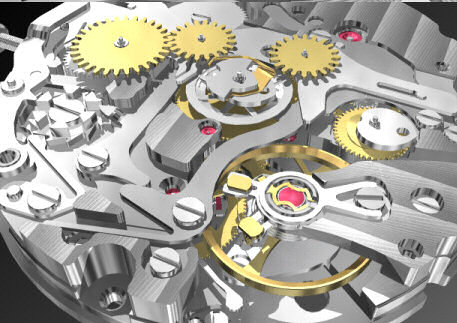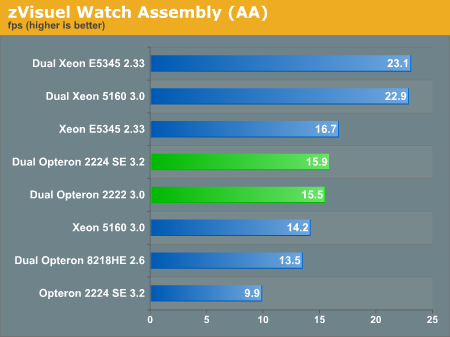Software Rendering
Some of you might remember the "Kribi" engine, an ultra-powerful real-time software rendering 3D engine. It seems like madness to invest time in a software 3D engine now that the GeForce 8800 has 128 small FPUs working at 1.35GHz, but software rendering is far from dead. The new Intel Core architecture can perform up to four 64-bit FP (3 sustained) instructions per clock cycle, and now we have cheap quad cores at 2.4GHz. That is a lot of FP power too, if you carefully optimize for it. That is exactly what the people of zVisuel in Lausanne, Switzerland have been doing. There are quite a few advantages for using software rendering. For example, the end result looks the same on every PC and it runs (although potentially faster or slower depending on hardware) on every PC. That is a big advantage for companies where many people use portables.
If you are still not convinced that real-time software rendering can offer great results, take a look at this movie.

An example what the zVisuel Kribi 3D Engine can create
Eric Bron provided us with a benchmark which is based on real world use by zVisuel's clients. The first benchmark does not use antialiasing.

As we explained here, the new Core architecture has theoretically twice the SSE2 power of the Athlon X2. Extremely carefully optimized SSE2 applications such as the 3D engine of zVisuel show that this leads to a 70% IPC advantage in practice. This shows very nicely why AMD needs the new K10 family: in this case the Athlon 64 architecture is starting to show its age.
We performed the same benchmark, but now antialiasing was applied.

AA clearly makes the application more memory intensive. The two quad core Xeons are only 38% faster than one CPU, while they were 50% faster in the previous benchmark. This helps the Opteron to make the gap a little smaller: the Xeon 3GHz is 48% faster clock for clock, instead of 70%.
Some of you might remember the "Kribi" engine, an ultra-powerful real-time software rendering 3D engine. It seems like madness to invest time in a software 3D engine now that the GeForce 8800 has 128 small FPUs working at 1.35GHz, but software rendering is far from dead. The new Intel Core architecture can perform up to four 64-bit FP (3 sustained) instructions per clock cycle, and now we have cheap quad cores at 2.4GHz. That is a lot of FP power too, if you carefully optimize for it. That is exactly what the people of zVisuel in Lausanne, Switzerland have been doing. There are quite a few advantages for using software rendering. For example, the end result looks the same on every PC and it runs (although potentially faster or slower depending on hardware) on every PC. That is a big advantage for companies where many people use portables.
If you are still not convinced that real-time software rendering can offer great results, take a look at this movie.

An example what the zVisuel Kribi 3D Engine can create
Eric Bron provided us with a benchmark which is based on real world use by zVisuel's clients. The first benchmark does not use antialiasing.

As we explained here, the new Core architecture has theoretically twice the SSE2 power of the Athlon X2. Extremely carefully optimized SSE2 applications such as the 3D engine of zVisuel show that this leads to a 70% IPC advantage in practice. This shows very nicely why AMD needs the new K10 family: in this case the Athlon 64 architecture is starting to show its age.
We performed the same benchmark, but now antialiasing was applied.

AA clearly makes the application more memory intensive. The two quad core Xeons are only 38% faster than one CPU, while they were 50% faster in the previous benchmark. This helps the Opteron to make the gap a little smaller: the Xeon 3GHz is 48% faster clock for clock, instead of 70%.










30 Comments
View All Comments
2ManyOptions - Monday, August 6, 2007 - link
... for most of the benchmarks Intel chips performed better than the Opterons, don't know why Intel should get scared from these, they can safely wait for Barcelona. Didn't really understand why you have out it as AMD is still in game with these in the 4S space.baby5121926 - Monday, August 6, 2007 - link
intel got scared because they dont want to see the real result from AMD + ATI.the longer intel lets AMD lives, the more dangerous intel will be.
that's why you guys can see Intel is attacking AMD really really hard at this meantime... just to kick AMD out of the game.
Justin Case - Monday, August 6, 2007 - link
What are the units in the WinRAR results table?coldpower27 - Monday, August 6, 2007 - link
Check Intel own pricing lists, and you will see that Intel has already pre-empted some of these cuts with their Xeon X5355 at $744 or Xeon E5345 at $455 and the "official" Xeon X5365 should be cout soon if not already...http://www.intel.com/intel/finance/pricelist/proce...">http://www.intel.com/intel/finance/pric...rice_lis...
TheOtherRizzo - Monday, August 6, 2007 - link
I know nothing about 4S servers. But what's the essence of this article? Surely not that NetBurst is crap? We've known that for years. Is the real story here that Intel doesn't really give a s*** about 4S, otherwise they would have moved on to the core 2 architecture long ago? Just guessing.coldpower27 - Monday, August 6, 2007 - link
Xeon 7300 Series based on the Tigerton core which is a 4 Socket Capable Kentsfield/Clovertown derivatives is arriving in Sepetember this year, so Intel does care in becoming more competitive in the 4S space, but it is just taking some time.They decided to concentrate on the high volume 2S sector is all first, since Intel has massive capacity, going for the high volume sector first makes sense.
mino - Monday, August 13, 2007 - link
Yes and no, actually to have two intel quads running on a single FSB was a serious technical problem.Therefore they had to wait for 4-FSB chipset to be able to get them out the door. Not to mention the qualification times which are a bit onger for 4S platforms that 2S.
AMD does not have these obstacles as 8xxx series are essentially 2xxx series from stability/reliability POW.
Calin - Monday, August 6, 2007 - link
The 5160 processor is Core2 unit, not a NetBurst one. Also, the 5345 is a quad core based on Core2jay401 - Monday, August 6, 2007 - link
People built 3.0GHz - 3.33GHz E4300 & E4400 systems six months ago that cost roughly $135 for the CPU. Others went for an E6300 or more recently an E6320, both again under $200.They were all relatively easy overclocks.
Why does anyone with any skill in building their own computer care about an $800+ CPU again?
Calin - Monday, August 6, 2007 - link
Why don't Ford Mustangs use a small engine, overclocked to hell? Like an inline 4 2.0l with turbo, and a high rpm instead of their huge 4+ liter engines?Why do trucks use those big engines, when they could get the same power from a smaller, gasoline, turbocharged engine?
People pay $800+ for processors that work in multiprocessor systems (your run of the mill Athlon64 or E4300 won't run). Also, they use error checking (and usually error correcting) memory in their systems - again, Athlon64 doesn't do this. They also use registered DDR in order to access more memory banks - your Athlon64 again falls short. On the E4300 side, the chipset is responsible with those things, so you could use such a processor in a server chassis - if the socket fits.